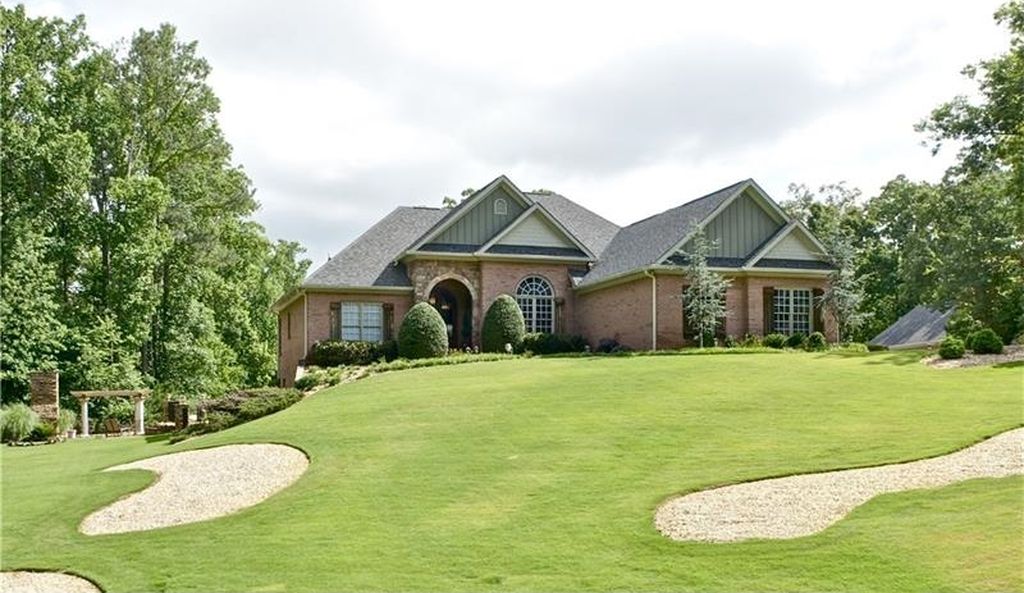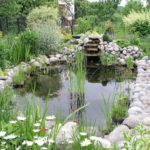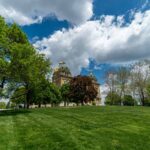
Warm-season Grass Types in Acworth, GA
If you’re planning to install a new lawn, you might want to do a “sightseeing tour” of the well-landscaped lawns that flourish throughout Acworth. When one especially appeals to you, stop and speak with the homeowner. Acworth residents are friendly and will welcome the chance to share their knowledge of grass and its care. You’ll get great advice, and you may end up with a new friend.
Temperatures in Acworth range, approximately, from the low 30s to the upper 90s, so that lawn will be made up of one of the warm-season grass types that originated in tropical areas and grow best in the brilliant Georgia sunshine and its summer temperatures. The predominant warm-season grasses used in Acworth are Bermuda, Centipede, St. Augustine, and Zoysia.
Bermuda Grass

Photo: Flickr / Scot Nelson
Bermuda is the most commonly used warm-season grass throughout the country and the perennial favorite in the South. It is also among the most drought-resistant grasses, because, when thirsty, its roots will reach down to draw on an available water source.
As its “port of entry,” Georgia has had a long association with Bermuda. During colonial times, Georgia’s governor, Henry Ellis, introduced the grass that originated in Africa and arrived in the U.S. via Bermuda.
Bermuda is a low-growing grass with gray-green, rough-edged blades and purple stems that produces a thick, dense lawn that thrives in full sun. It’s stubborn and aggressive—good qualities in grass. You can have a full lawn in one year, because its shoots, both above the ground (stolons) and below (rhizomes), spread rapidly.
Bermuda’s needs are fairly simple. Make sure it gets plenty of sun (it won’t grow in shade), mow it properly, water and aerate it. It tolerates heavy traffic.
Grass Seed Options:
– Scotts Turf Builder Bermudagrass (10-lb. bag)
– Hancock Seed Co. Bermudagrass (50-lb. bag)
Centipede Grass

Photo: Flickr / Forest and Kim Starr
Centipede is known as the “Lazy Man’s” grass. It could just as well be known as the “Smart Man’s (or Woman’s)” grass. You’ll spend less time mowing, watering, and fertilizing than your neighbors who live with other grass types.
Centipede is native to China and southeast Asia and was first introduced into the United States in 1916 by agricultural explorer, Frank N. Meyer. It’s a low-growing (and slow-growing) medium-textured grass with a bright yellow-green color. Its stolons have short upright stems that grow to about 3-5 inches (and look like centipedes).
Centipede doesn’t need mowing as often as other grasses and requires only once-a-year fertilizing. It can tolerate a bit of shade and short-lived droughts. It’s resistant to weeds, insects, and diseases. What’s not to like?
Well, for one thing, it can only tolerate light traffic. More important, though, it lives up to the old saying: “First year sleeps, second year creeps, third year leaps.” In other words, you’ll need patience waiting for your lawn. However, if you can wait, the time will be returned to you many times over throughout the years with this low-maintenance grass.
Grass Seed Options:
– Gulf Kist Coated Centipedegrass Seeds (1 lb.)
– Scotts EZ Seed Patch and Repair Centipedegrass (3.75 lbs.)
– TifBlair Centipedegrass (5-lb. bag)
St. Augustine Grass

Photo: Flickr / Dũng Đỗ Hữu
St. Augustine is the most shade-tolerant of the warm-season grasses. It also retains its color better during drought periods than its fellow grasses.
The bright light green to dark green grass is native to Western Africa, the West Indies, and the Gulf of Mexico. At first glance, it could be mistaken for Centipede, but its blades are thicker and wider and the tips are not as pointed.
St. Augustine is coarse and dense, low-growing, and aggressive. It spreads rapidly via stolons. It does reasonably well in light shade and very well in extreme heat or drought. Those thick blades trap moisture close to the ground, and so it performs well in dry conditions. Usually, it needs watering every five to ten days. You want to supplement that during droughts.
The dense ground cover is sturdy enough to compete with most weeds, but it handles only light traffic. You can let the dog out to romp on it, but keep the marching band off of it.
Grass Plug Options:
– Seed Ranch St Augustine Seville Grass Plugs (2 Trays)
– Seed Ranch St Augustine Floratam Grass Plugs (2 Trays)
Zoysia

Photo: Flickr / Forest and Kim Starr
Zoysia stays green longer than other warm-season grasses and is one of the most “traffic friendly” of all grass types.
This deep green, dense grass is native to China and other parts of Southeast Asia. It was brought to the United States in 1911 from Manila. Zoysia grows slowly and it may be two years before you have a fully established lawn. But you will then have a lawn that is a superb performer without high-maintenance needs. It is fine with heat and drought, grows in full sun to light shade, and is not prone to weeds, pests, and diseases.
It spreads via stolons, and it is unconcerned where it wanders. Deep edging is recommended to protect flower beds and sidewalks from invasion.
As with any slow-growing grass, the trade-off is that it needs less frequent mowing—and less frequent watering due to its deep roots. Water thoroughly once a week or every other week.
A Zoysia lawn may be the ultimate in outdoor luxury. Its fine to medium texture and its cushiony density result in a plushness that, beneath your bare feet, will rival your finest carpet.
Grass Plug and Seed Options:
– Zoysia Plugs (50 Large Grass Plugs)
– Zoysia Plugs (50 Full & Lush Grass Plugs)
– Zoysia Plugs (100 Plugs)
– Zenith Zoysia Grass Seeds (1/8 lb. of seeds)
Have questions about lawn care? Visit our Acworth, GA lawn care page or share your thoughts in the comments section below.
LawnStarter participates in the Amazon Services LLC Associates Program, an affiliate advertising program. LawnStarter may earn revenue from products promoted in this article.





